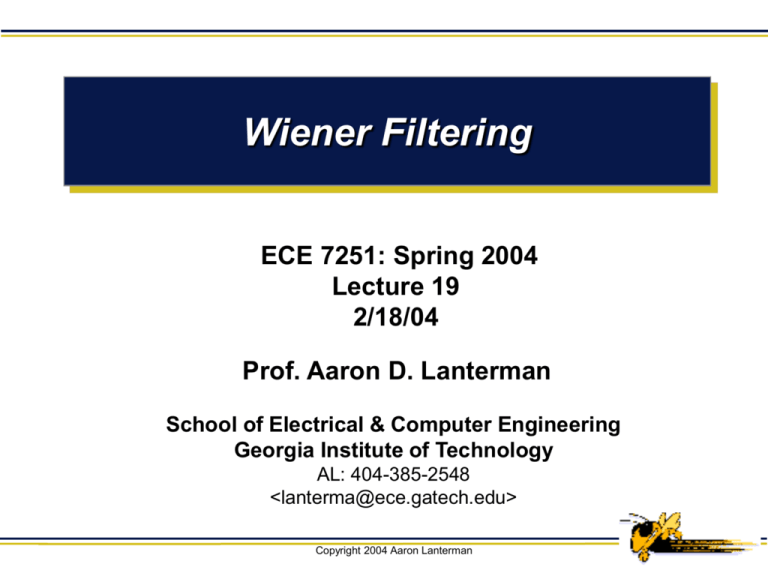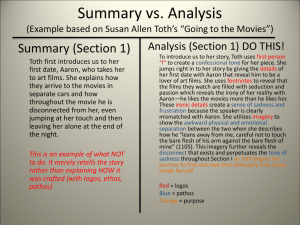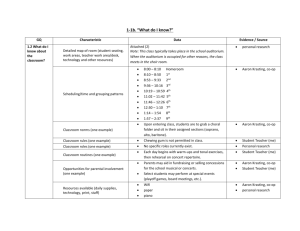Mean Square Error
advertisement

Wiener Filtering
ECE 7251: Spring 2004
Lecture 19
2/18/04
Prof. Aaron D. Lanterman
School of Electrical & Computer Engineering
Georgia Institute of Technology
AL: 404-385-2548
<lanterma@ece.gatech.edu>
Copyright 2004 Aaron Lanterman
The Setup
• Context: Bayesian linear MMSE estimation
for random sequences
• Parameter sequence { k , k Z}
• Data sequence {Yk , k I Z}
• Goal: Estimate { k } as a linear function of
the observations:
ˆk ( y) h(k , j ) y j
jI
• Find h to minimize mean square error
Copyright 2004 Aaron Lanterman
O.P. to the Rescue
•
By the orthogonality principle,
*
k
k
i
*
j
k
i
jI
*
E[(ˆ (Y ) )Y ] 0 for i I
E[( h(k , j )Y )Y ] 0
h(k , j ) E[Y Y ] E[ Y ]
h( k , j ) r ( j , i ) r ( k , i )
j i
jI
Y
jI
•
*
k i
Y
If processes are stationary, we can write
h( k , j ) r ( j i ) r
jI
Y
Y
slight abuse of notation
Copyright 2004 Aaron Lanterman
(k i )
WienerHopf
Equation
Spectral Representation
• If I Z it turns out the filter is LTI:
h( k j ) r ( j i ) r (k i )
WLOG, consider i=0: h(k j )r ( j ) r
jI
Y
Y
jI
Y
Y
(k )
• Can solve W-H in the Z-transform domain:
H ( z )SY ( z ) SY ( z )
SY ( z )
H ( z)
SY ( z )
Copyright 2004 Aaron Lanterman
Mean Square Error (1)
2
ˆ
• MSE = E[| (k (Y )) | ]
ˆ
ˆ
E[(k (Y ))(k (Y ))]
(by O.P.)
ˆ
E[(k (Y ))k ] E[(k ˆ(Y ))ˆ (Y )]
ˆ
E[k ] E[ k (Y )k ]]
k
Copyright 2004 Aaron Lanterman
Mean Square Error (2)
ˆ
MSE E[k ] E[ k (Y )k ]]
E[k ] E[ h(k j )Y j k ]]
k
k
jI
E[ k ] h(k j ) E[Y j ]
k
jI
r (0) h(k j ) rY ( j k )
jI
• Since everything is stationary, can just take k=0
MSE r (0) (h rY )(0)
Copyright 2004 Aaron Lanterman
k
Mean Square Error (3)
MSE r (0) (h rY )(0)
S
( ) H ( ) SY ( )d
SY ( )
S ( )
SY ( )d
SY ( )
| SY ( ) |
S ( )
d
SY ( )
2
Copyright 2004 Aaron Lanterman
Deblurring
• Suppose object is observed through a blurring point
spread function f and additive noise W
Yk ( f )k Wk
• Suppose and W are uncorrelated zero-mean
• Recall from ECE6601:
2
Y
W
Y
Y
S F S S and S
•
F S
So the Wiener filter is
SY ( z )
F ( z ) S ( z )
H ( z)
2
SY ( z )
F ( z ) S ( z ) SW ( z )
Copyright 2004 Aaron Lanterman
Interpretation of the Deblurring Filter
• If noise is negligible, i.e. SW ( ) 0
F S
F S
1
H ( ) 2
F S SW FF S F
• Even if there is no noise, in
implementation, straight division by
F() is often ill-posed and not a good
idea (round off errors, etc.)
Copyright 2004 Aaron Lanterman
Deblurring Error
| SY ( ) |
MSE S ( )
d
SY ( )
2
2
F ( ) | S ( ) |
S ( )
d
2
F ( ) S ( ) SW ( )
2
S [ F S SW ] F | S |
2
2
F S SW
2
S SW
F S SW
2
d
Copyright 2004 Aaron Lanterman
2
d
Competing Approaches
• Competing approaches include
iterative methods such as the
“Richardson-Lucy” algorithm (an
EM-style procedure)
– Computationally intensive
– Can naturally incorporate nonnegativity
– Sometimes better match to real
statistics
Copyright 2004 Aaron Lanterman
Discussion
• Advantage of Wiener approach:
– LTI filtering implementation
• Disadvantages of Wiener approach:
– No natural way to incorporate
nonnegativity constraints (in image
processing, for instance)
– Only truly optimal for Gaussian
statistics
Copyright 2004 Aaron Lanterman
Real-Time Wiener Filtering
• What if we don’t have “future”
measurements?
• Must restrict h to be causal
• Solution:
1 SY ( z )
H ( z)
SY ( z ) SY ( z )
where the meaning of the plus and minus
superscripts and subscripts will be defined
on later slides
Copyright 2004 Aaron Lanterman
Spectral Factorization
• If Y has a spectrum satisfying the PaleyWiener criterion:
log S
Y
( )d
then the spectrum can be factored as
SY ( ) S ( ) S ( )
Y
where
1
Y
1
Y
Y
FF {S } is causal
FF {S } is anticausal
Copyright 2004 Aaron Lanterman
Factoring Rational Spectra
• If the spectrum is a ratio of polynomials, we can
factor as
Y
Y
Y
Y
1
SY ( z ) S ( z ) S ( z ) S ( z ) S ( z )
Poles and zeros
inside unit circle
Poles and zeros
outside unit circle
• Aside: spectral factorization into causal and
anticausal factors is analogous to Cholesky
decomposition of a covariance matrix into lower
and upper triangular factors
Copyright 2004 Aaron Lanterman
Causal Part Extraction
• We can split f into its causal and anticausal parts:
f (k ) { f (k )} { f (k )}
causal
anticausal
f (k ) f (k )u(k ), { f (k )} f (k )u(k 1)
• Use similar notation for Z-transform domain
F ( z ) {F ( z )} {F ( z )}
1
{F } ZZ {Z
Z {F }u (k )}
1
{F } Z
Z {ZZ {F}u (k 1)}
Copyright 2004 Aaron Lanterman
How to Extract Causal Parts
• If F is a ratio of polynomials can usually do
a partial fraction expansion:
F ( z ) {F ( z )} {F ( z )}
Poles and zeros
inside unit circle
Poles and zeros
outside unit circle
• Can also do polynomial long division (see
Ed Kamen’s book)
• Almost always a total pain and really
annoying
Copyright 2004 Aaron Lanterman



